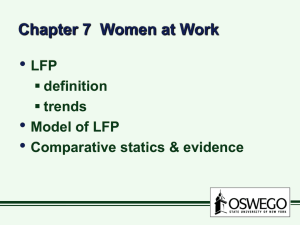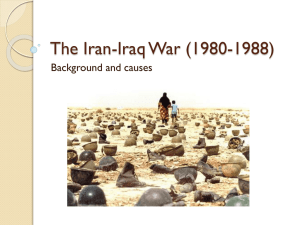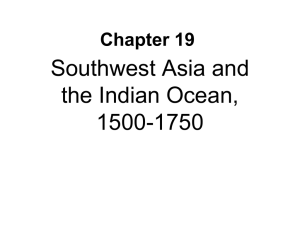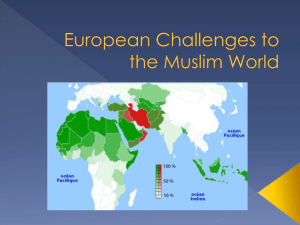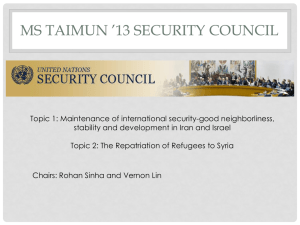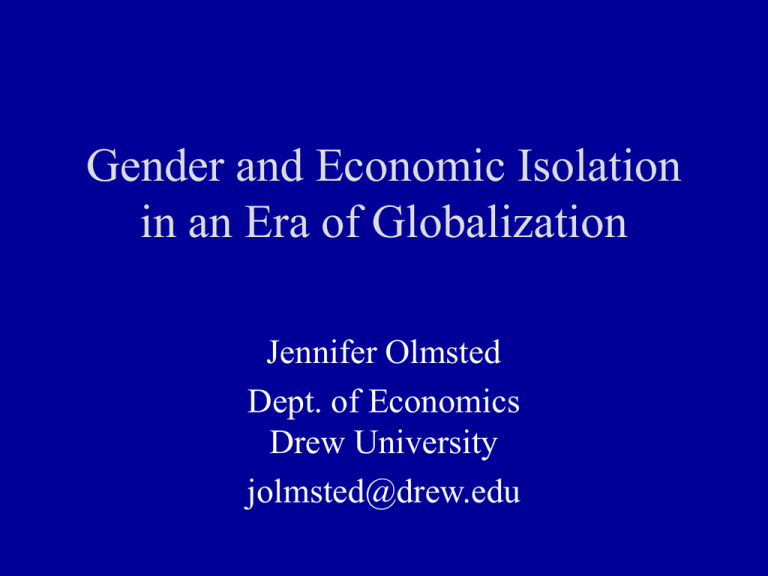
Gender and Economic Isolation
in an Era of Globalization
Jennifer Olmsted
Dept. of Economics
Drew University
jolmsted@drew.edu
Globalization
• Causes
– Technological innovation
• Transport/manufacturing/telecommunication
– Role of policies
• Structural adjustment
– Increased mobility of capital and goods (labor to a lesser extent)
• Benefits
– Economic growth
– Expanded choice/variety
• Risks
– Increased volatility
– Small countries more vulnerable to threat of economic
isolation
• Implications of that increased risk by gender/class
Externally imposed restrictions
• Multi-lateral sanctions
– Eg: Iraq/Sudan
• Unilateral
– Eg: Cuba/Iran
• Other examples
– Eg: Palestine – pre and post 2007
Gender and Globalization Literature
– Reduction in trade barriers linked to rising female
employment
• Rise of male unemployment?
• Women’s wages lower?
• Types of industries that are expanding are female dominated?
– Debate over whether globalization beneficial to women
• Female employment = female empowerment
• Work conditions
• Double burden
– Mehra and Gammage (1999) and Beneria (2003)
– Assumption of universal trend!
• What can an examination of sanctioned countries tell us about
how gender and globalization interact?
Externally Imposed Economic Isolation
• Effectiveness of sanctions in reaching policy objectives:
– Hufbauer, Schott and Elliot (1990)
• Measuring impact on macroeconomic indicators:
– National income
• Iran:Torbat (2005) annual reduction of 1.1% to GDP
• Iraq/Palestine: Olmsted (2006)
– 50/40 % decline in per capita income in two year period respectively
• USA: Gravity model Hufbauer and Oegg (2003)
– Labor outcomes
• Palestine: Ruppert-Bulmer (2003)
• Humanitarian issues: - eg poverty rates/health outcomes
• Iraq: Garfield (1999), Niblock (2001)
• Palestine: World Bank (2003)
Gender and Sanctions
• Focus primarily on health/well-being outcomes
– Maternal and infant mortality
– Education outcomes
– Olmsted (2006) compares Palestine and Iraq – finds minimal
gender differences
• Minimal research on gendering of employment effects
– Assumption that economic hardship will cause women’s labor
force participation to rise (added worker effect)
• Amnesty International (2004)
– Assumption that lack of increase in employment can be explained
by gender norms not macroeconomic conditions
• ILO (2004)
Effect of Sanctions on Female Employment
• Changes to Economy
– Trade volume declines
• Female employment may decline, depending on types of jobs they
previously held
– National income declines
• Theory unclear on effect on female labor force participation
– ‘added worker effect’ – household income declines/women’s labor force
participation rises
– ‘crowding out effect’ – women pushed out of labor market
• Changes in government policy
– Difficulties maintaining programs
– Attempts to reduce negative employment impact
Summary of findings
• Women’s Labor force participation rate (LFP) negatively impacted
– very little evidence of added worker effect
– some evidence of crowding
– Evidence that women’s employment tied to trade openness
• Return to subsistence agriculture may mask actual decline in LFP
• Less skilled/poorer women most likely to lose jobs since they are in
traded sectors
• Some industries may become defeminized as a result of economic
hardship
• Government employment tends to benefit educated women, not those
losing jobs in traded sector
• Government inability to sustain programs may affect female
employment
• Trends may vary depending on structure of local economy
• Studying Iran of particular interest since female LFP rising despite
sanctions
Women’s Labor Force Participation (LFP) in MENA
• Trends
– LFP lagged other parts of the world, despite rising literacy rates
– Very low rates of women’s employment in manufacturing
• Exceptions: Morocco, Algeria, Iran and Palestine
– Female LFP rates rising more rapidly in MOST countries in recent
years.
• Closer look at Iran, Iraq, Palestine, Sudan and (Turkey) warranted
• Proposed explanations:
– Measurement problems
– Gender norms/Islam/Fertility
• Tzannatos (1999) finds that Muslim and Catholic countries both have
lower female LFP rates
– Economic structure
• Moghadam (1995) argues that Import Substitution policies kept
female LFP rates low. Cites North Africa as exception
Data Sources
• ILO – KILM
• ILO – Laborsta
• Palestine – PCBS Labor force survey
• Iran – Statistical Center Census data
TABLE 1 - FEMALE LABOR FORCE PARTICIPATION RATE (LFP)
Country
LFP
LFP
CHANGE IN
RANK
RANK
FEMALE
FEMALE
LFP
1995
Algeria
Bahrain
Egypt
Iran
Iraq
Israel
Jordan
Kuwait
Lebanon
Libya
Morocco
Oman
Palestinian
Territories
Qatar
Saudi Arabia
Sudan
Syria
Tunisia
Turkey
UAE
Yemen
AVERAGE
2005
8.0
17.0
9.0
19.0
23.0
45.6
10.0
27.0
25.0
19
12
16
10
7
1
15
3
6
21.0
9.0
2005-1995
7
11
18
3
20
1
14
2
8
9
15
17
27.7
12.3
11.1
19.6
-10.0
4.5
17.5
22.0
7.4
9
16
35.7
29.3
20.1
38.6
13.0
50.1
27.5
49.0
32.4
32.1
26.8
22.7
14.0
14
10.3
21
-3.7
19.0
9.0
26.0
16.0
26.0
45.0
23.0
10
16
4
13
4
2
7
36.3
17.6
23.7
38.6
28.6
27.7
38.2
29.7
29.9
6
19
16
3
12
13
5
10
17.3
8.6
-2.3
22.6
2.6
-17.3
15.2
20.6
SOURCE: ILO KILM,
http://www.ilo.org/public/english/employment/strat/kilm/index.htm
5.8
13.7
9.2
YR
19
8
YR 0
19
8
YR 1
19
8
YR 2
19
8
YR 3
19
8
YR 4
19
8
YR 5
19
8
YR 6
19
8
YR 7
19
8
YR 8
19
8
YR 9
19
9
YR 0
19
9
YR 1
19
9
YR 2
19
9
YR 3
19
9
YR 4
19
9
YR 5
19
9
YR 6
19
9
YR 7
19
9
YR 8
19
9
YR 9
20
0
YR 0
20
0
YR 1
20
0
YR 2
20
0
YR 3
20
0
YR 4
20
0
YR 5
20
06
60
50
40
30
20
10
0
Algeria
Bahrain
Egypt
Iran
Iraq
Jordan
Kuwait
Lebanon
Libya
Morocco
Oman
Saudi Arabia
Tunisia
UAE
West Bank/Gaza
Table 3 - Female LFP for Iran
1976
1986
1996
2006
12.9
8.2
9.1
12.5
TABLE 2 - WOMEN'S PARTICIPATION BY SECTOR FOR AVAILABLE MENA COUNTRIES, VARIOUS YEARS
Country
YEAR
Algeria
2003
AGRI
%
10.9
Bahrain
1991
2001
0.0
0.1
5.9
12.1
7
5
3.8
5.6
10.0
7.1
16.3
13.1
8.2
7.3
48.8
49.7
Egypt
1997
2003
40.4
39.0
6.9
4.8
6
10
6.5
6.3
11.4
12.8
22.4
22.5
6.0
7.3
0.0
0.0
Iran, Islamic Republic of
1996
2006
16.7
14.5
33.0
23.4
1
1
2.2
5.3
5.6
2.7
26.0
24.0
6.7
8.9
8.8
20.2
Iraq
2004
32.6
6.5
9
5.1
16.3
29.8
4.5
0.0
Jordan
2003
2.0
10.6
6
5.5
5.1
40.6
13.8
16.4
Morocco
2002
2005
57.1
61.4
18.5
15.5
3
4
3.7
5.1
3.7
14.9
13.1
Oman
1996
2000
4.7
5.3
5.2
11.6
8
5
6.9
6.2
26.0
8.7
32.8
41.4
9.3
14.1
7.1
7.7
Palestinian Territories
1996
2004
29.0
33.7
15.2
8.0
2
7
8.8
7.1
5.2
5.8
27.4
28.0
7.6
8.2
4.8
2.2
Qatar
1997
2004
0.0
0.1
0.4
0.6
11
12
1.5
3.3
5.9
9.5
21.8
19.3
7.6
9.6
51.8
45.6
Saudi Arabia
1999
2002
1.0
0.6
1.2
1.1
10
11
0.5
0.7
2.5
2.2
40.0
41.7
8.5
6.4
36.3
36.3
Syrian Arab Republic
1994
2003
29.4
49.1
14.5
6.8
3
8
2.8
3.5
14.5
12.4
29.8
21.6
2.3
2.5
3.7
0.0
United Arab Emirates
1995
0.1
12.1
4
6.5
4.4
16.4
7.2
49.3
Yemen
1994
86.8
2.6
9
1.1
2.5
3.5
1.0
0.0
41.9
36.1
21.1
21.9
World
1996
2006
MANU RANK SALES PUBLC EDUC HEALTH OTHER
%
%
%
%
%
%
22.5
2
2.9
12.1
24.4
10.9
14.3
0.0
0.0
37.0
42.0
SOURCES: International Labor Office (ILO) LABORSTA data available through the KILM database
http://www.ilo.org/public/english/employment/strat/kilm/index.htm
http://www.ilo.org/public/english/employment/strat/kilm/download/kilm04.pdf (World figures)
Iraq
• Micro level labor force data unavailable
• LFP rate stagnated in 1980s and 1990s
• anthropological studies
– Cainkar (1993) and Al Ali (1995)
• Educated women exited labor market due to
declining wages/benefits
• Less educated women may have been driven into
market due to economic hardship
Palestine: 1995 – 2003
• Female Labor Force Participation appears flat
• A closer examination of the data suggests:
– Decline in women’s access to wage employment
• Unpaid ag rises from 27 to 50% of all female employment
• Less educated women’s employment declining
– Decline in textiles/apparel sector from 14 to 8 % of all female
employment
– Particularly stark in Gaza – from 17 to 2 %
• Educated women’s employment has risen
– Government sector growing from 17 to 23%
• Defeminization of the health care sector
– From 10 to 5% of all female employment
– From 50% to 14% of all health care workers
YR
19
8
YR 0
19
8
YR 1
19
8
YR 2
19
8
YR 3
19
8
YR 4
19
8
YR 5
19
8
YR 6
19
8
YR 7
19
8
YR 8
19
8
YR 9
19
9
YR 0
19
9
YR 1
19
9
YR 2
19
9
YR 3
19
9
YR 4
19
9
YR 5
19
9
YR 6
19
9
YR 7
19
9
YR 8
19
9
YR 9
20
0
YR 0
20
0
YR 1
20
0
YR 2
20
0
YR 3
20
0
YR 4
20
0
YR 5
20
06
60
50
40
30
20
10
0
Algeria
Bahrain
Egypt
Iran
Iraq
Jordan
Kuwait
Lebanon
Libya
Morocco
Oman
Saudi Arabia
Tunisia
UAE
West Bank/Gaza
19
YR 80
19
YR 81
19
YR 82
19
8
YR 3
19
YR 84
19
YR 85
19
YR 86
19
YR 87
19
8
YR 8
19
YR 89
19
YR 90
19
YR 91
19
9
YR 2
19
YR 93
19
YR 94
19
YR 95
19
YR 96
19
9
YR 7
19
YR 98
19
YR 99
20
YR 00
20
0
YR 1
20
YR 02
20
YR 03
20
YR 04
20
YR 05
20
06
YR
45
40
35
30
25
20
15
10
5
0
Iran
Iraq
Jordan
West Bank/Gaza
Palestine: 1995 – 2003
• Female Labor Force Participation appears flat
• A closer examination of the data suggests:
– Decline in women’s access to wage employment
• Unpaid ag rises from 27 to 50% of all female employment
• Less educated women’s employment declining
– Decline in textiles/apparel sector from 14 to 8 % of all female
employment
– Particularly stark in Gaza – from 17 to 2 %
• Educated women’s employment has risen
– Government sector growing from 17 to 23%
• Defeminization of the health care sector
– From 10 to 5% of all female employment
– From 50% to 14% of all health care workers
Role of Internal vs. Global Factors?
• Role of Gender norms
– Interviews with working class women suggest that society
becoming more accepting of women working
– Evidence from health sector suggests defeminization
• Role of Internal policy
– PA job creation
• Biased in favor of educated, particularly in case of women
• Role of External policies
– Israel:
• closure policies made investment in WB/GS less appealing
– US:
• Jordan and Egypt duty free imports w/Israeli joint ventures as reward
for participation in peace process
– Jordan’s exports to US rise from $2 million to $567 million btw 1999 and 2003
Iran 1976-2006
• Female Labor Force Participation dropped after
revolution and then rose.
• A closer examination of the data suggests:
• Iranian manufacturing sector important, but declining
employer of women
• Carpet weaving experienced decline and then rise in
employment btw 1976 and 2006
• Low and declining rates of public sector employment
– Educated women benefit most from public sector
• High rate of informal sector employment
Table 3 - Female LFP for Iran
1976
1986
1996
2006
12.9
8.2
9.1
12.5
Iran
• Female Labor Force Participation dropped after
revolution and then rose.
• A closer examination of the data suggests:
• Iranian manufacturing sector important, but declining
employer of women (33 to 23%)
• Carpet weaving experienced decline and then rise in
employment btw 1976 and 2006
• Low and declining rates of public sector employment
– Educated women benefit most from public sector
• High rate of informal sector employment
Role of Internal vs. Global Factors?
• Role of Internal Policies:
– Focus of existing literature on ideological shift after
Islamic Revolution
• F. Moghadam 1994, Alizadeh 2003, V. Moghadam 2003,
Nomani and Behdad 2006
• Role of Global Factors?
– Sanctions
• Beginning in 1979 US imposed sanctions on Iran
– Migration Patterns
• Post-revolution brain drain
• Afghan war led to Iran becoming host to large number of
refugees
Sanctions:
• Although overall impact on national income small,
manufacturing sector particularly affected by sanctions
– 50% of female employment was in manufacturing pre-revolution
• Carpet industry employed large numbers of young, uneducated
Iranian women
• Data suggest the number of women in this industry declined from
606,646 to 337,436 between 1976 and 1986 (Karimi forthcoming)
• 30% decline in female carpet industry jobs (conservative
estimate) could lead to 2 percentage point drop in female
LFP (eg from 12.9 to 10.9)
Migration:
• Iran suffered large high brain drain
– Carrington and Detragiache (1998)
• 20% exodus of educated women could explain further 0.4%
drop, due to educated women’s relatively high LFP rates.
• Influx of Afghan refugees
– Not clear how/whether Afghan refugees incorporated
into census
– Karimi (forthcoming) argues they drove down wages in
low skill markets
Conclusions
• Experience of “Globalization” not universal
– Iraq, Iran and Palestine three communities with reduced
access to international markets in recent years
• Critics of globalization ignore far worse fate –
economic isolation
• Sanctions literature has focused mainly on
consumption and economic well-being, but labor
implications also important to consider
Conclusions continued
Explaining female employment
• Trade restrictions may have gender/class
implications
– Less educated women (and men) often more dependent
on traded sector
• Minimal evidence of added worker effect
• Some evidence of crowding out
• Emphasis on ideological/gender norm supply side
explanation of female labor force participation
may ignore macroeconomic conditions
• Need for considerable more research
Further research:
• Single country time series analysis of female labor force
participation, to link employment and macro trends
– Further analysis of Iran particularly interesting – rising
employment despite shrinking government sector and sanctions
• Microeconomic analysis of wages
– Hypothesis:
• Shift in size of education/sex wage gap:
– preliminary analysis of Palestinian data suggests this may not be the case
(wage rigidities?)
• Analysis of income distribution
– Hypothesis:
• Household income inequality worsening due to:
– Rising number of educated two earner families
– Decline in access of less skilled women to wage labor
Further research continued:
• More rigorous cross-country econometric study
– Challenges:
• Consistent measure of female labor force participation
• Consistent measure of economic openness
– Need to distinguish self-imposed isolation from externally
imposed
• Regional study of the post peace process
economies of Jordan/Egypt/Palestine/Israel
• Theoretical exploration of relationship between
gender norms and economic conditions
– Gender norms can shape economic outcomes
– Economic outcomes can (re)shape gender norms
• Questions?
• Contact information:
• jolmsted@drew.edu





